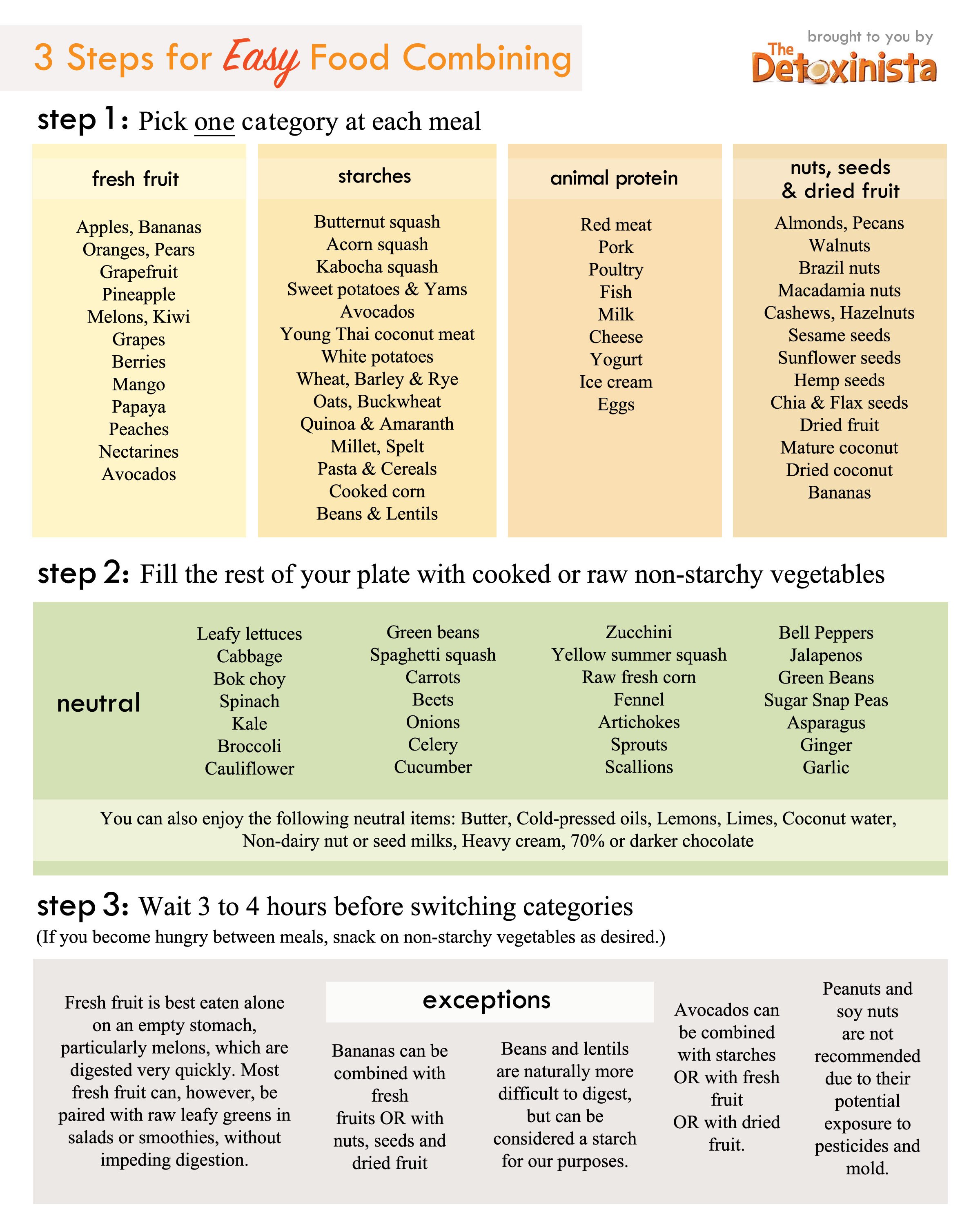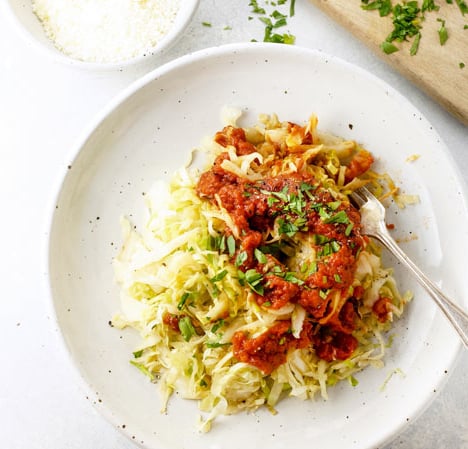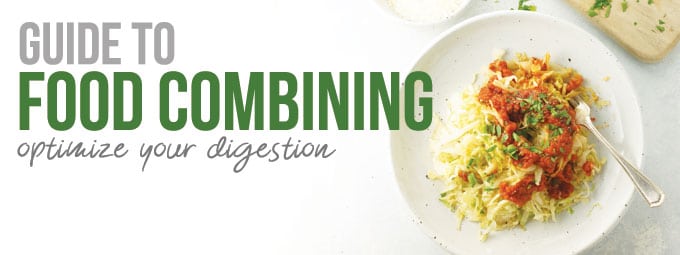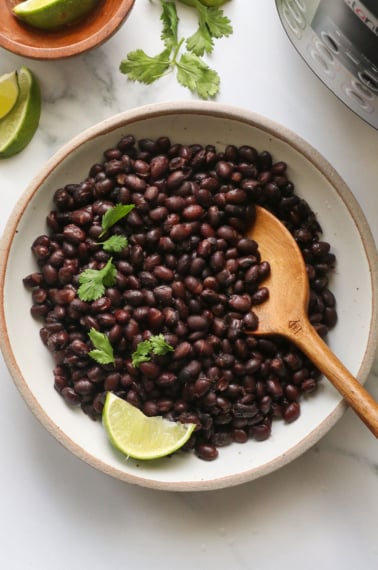This post may contain affiliate links. Please read my disclosure and privacy policy.
Did you know that digesting food requires more energy than any other function in the human body? It’s no wonder we’re exhausted after a big lunch! It stands to reason, then, that the best way to free up some extra energy is to make our digestion as quick and efficient as possible.
Food combining is one of my favorite tricks to streamline the digestive process. Though food combining principles can get very complicated, depending on which expert you ask, I prefer to keep them simple. Simply pick just one dense food at each meal, whatever you’re craving most at that moment, and then fill the rest of your plate with raw and cooked non-starchy vegetables. Easy! By simplifying your meals, the digestive system doesn’t have to tackle too much in one sitting, helping you to avoid that bloated, sluggish feeling that can put a damper on the rest of your day.
Studies have shown that humans have a tendency to overeat when we are offered a wide variety of foods during a meal. (source) So, by simplifying our meals, we will naturally eat less, without counting calories or worrying about portion sizes.
Best of all, you don’t have to give up any food groups that you love– you just may not want to eat them all at the same time. The following guide should help!
 (click on chart above to enlarge or print)
(click on chart above to enlarge or print)
As you can see in the chart above, the foods have been divided into four general categories:
- FRESH FRUIT
- STARCH
- ANIMAL PROTEIN
- NUTS/SEEDS/DRIED FRUIT
Note: Look for these food combining labels clearly marked in my cookbooks, and here on the blog. All of the recipes in my cookbooks are properly combined, and both cookbooks include properly combined meal plans to help you easily get started.
For a properly combined meal, simply choose ONE category and only eat foods out of that category for that particular meal. The foods listed within the same category combine well with each other, and you may also include anything from the “Neutral” column to fill out your plate.
Wait 3-4 hours between each meal, before switching categories.
—
Properly Combined Sample Meal Ideas
A properly-combined STARCH meal might look something like this:
A sandwich on whole-grain bread, filled with avocado, mustard, lettuce, tomato and sprouts. Served with a leafy side salad and a baked sweet potato topped with butter. You could follow this meal with some dark chocolate for dessert!
A properly-combined ANIMAL PROTEIN meal might look something like this:
A leafy green salad topped with cherry tomatoes and goat cheese, followed by a piece of baked fish served with a side of roasted broccoli and cauliflower. You could follow this meal with some dark chocolate or goat’s milk ice cream for dessert!
A properly-combined NUT/SEED/DRIED FRUIT meal might look something like this:
A leafy green salad topped with dried cranberries and raw walnuts, followed by a platter of raw hummus served with raw crudités. Dessert could be a slice of raw cheesecake, a few raw macaroons, or a couple raw almond butter cups!
FRESH FRUIT is best eaten in the mornings, on an empty stomach.
This is because fruit digests so quickly, typically within 30 minutes of eating. (However, fruit can be combined with leafy green vegetables in a green smoothie, if you like!) Fruit is not recommended as a dessert after a meal, as it could potentially cause fermentation, gas and bloating, and promote bacterial overgrowth in the body. You can eat fruit as an afternoon snack or post-workout, as long as it’s been 3-4 hours since your last properly-combined meal.
—
Note: There is a lot of debate over the science behind food combining, without much evidence to back it up. (There is little money to be made in this field, which probably accounts for the lack of funded studies.) Personally, I think why food combining works for me, and for many others, is that it encourages you to make better choices, without feeling restricted. When you’re choosing just ONE food category at a time, then filling the rest of your plate with raw and cooked vegetables, you’re bound to be making healthier choices! So, food combining may just work because it encourages the consumption of more whole foods and simpler meals.
I think it’s also important to note that there’s no need to be “perfect” with food combining rules all the time. I like to follow the 80/20 rule, because life’s too short to stress about what you’re eating.
For properly combined meal plans and entertaining menus, be sure to pick up a copy of my first cookbook, Everyday Detox.
My second cookbook, No Excuses Detox, has 3 more meal plans, including a Budget-Friendly properly combined meal plan that feeds you for less than $6 each day, and a Speedy Meal plan that has everything ready in 30 minutes or less. Both of my cookbooks are loaded with properly combined recipes to help make things easier for you.













Thank you so much for your reply. I think I will continue to add the chia seeds for breakfast but will incorporate the rest as much as I can without letting my diet dictate my life! I loved this website. Last night we went for mexican food, and I made sure to get a burrito with bean and avacado vs the typical bean and cheese thanks to your website. The fruit things an eye opener too- would never had known! Starch wise, whats confusing is “dry beans” are considered to be a starch while beans also fall under a low starch category on other websites. Can you define starchy veggies?
I personally consider beans, potatoes, and winter squash to fall into the “starchy” category. In terms of starchiness, it all depends on what you’re comparing it to. In comparison to leafy greens, beans would be considered pretty starchy. But, compared to a loaf of white bread, beans would be considered “low-starch.”
Hi!
Am I allowed to eat fruit + yoghurt? Or milk?
Or should I use soy milk?
Is it ok to eat oatmeal with soy milk?
Thanks a lot!
I don’t care for the term “allowed,” since you are always welcome to eat anything you like! For food combining purposes, fruit would be eaten alone, so without any dairy. I personally avoid soy milk myself, but non-dairy milks are generally considered neutral and can be enjoyed over cereals.
Hi, I usually have overnight oats:
oatmeal, almond milk- but the kicker here is chia seeds. Can I include those? What about Greek yogurt and chia seeds? So no greek yogurt and strawberries etc either?
Yes, it sounds like you got it! It’s not easy to adjust to new food combinations at first, but with practice, it does become an easy habit. Please don’t feel pressure to give up your usual healthy combinations, though, since food combining isn’t always for everyone.
Hi, there! I really appreciate the spirit of this page, but a better approach to naturally aiding digestion is lowering your FODMAP intake. Here is a link to Sue Shepherd’s website, a doctor in Australia who has done extensive research into the low FODMAP diet: http://shepherdworks.com.au/disease-information/low-fodmap-diet
Her advice was specifically formulated for people with Irritable Bowel Syndrome, Fructose Malabsorption (which I have), Gluten Intolerance, and Lactose Intolerance, which all cause pain and bloating after consuming different foods. However, even “normal” people will benefit from reading and understanding the mechanics of digestion of FODMAP’s, categories of foods that all people have trouble digesting. Those of us with intolerances have fewer of the enzymes that “normal” people have, but even “normal” people have a limited amount of each category of enzymes that deplete as the food is digested. (See: http://en.wikipedia.org/wiki/FODMAP)
As an example, eating an all-fruit meal will overload your small intestine with fructose, one of the naturally occurring sugars. As the food passes through, the enzymes that move the fructose through the intestine wall are depleted. The fructose then passes into the large intestine, where the gut bacteria feed vociferously. This causes gas, bloating, flatulence, and pain.
Hope this helps.
hi samantha! i have IBS and am roughly following a low FODMAPs diet. do you have any more sources I can look at? thanks!
It’s my understanding that melons do not combine well with anything else- including other fruits as they’re listed in category 1 of your chart. They’re good for you, but any melon should be eaten by itself.
Yes, that’s true! I didn’t make it clear on my chart, but I always recommend eating melons alone.
Hmmm this smells like a bunch of bullshit to me!
You’re welcome to have your own opinion.
Jenna,
You have a blunt approach to matters
as I can clearly see in your B.S. response.
As a healthcare professional for 38 years,
I have struggled with indigestion and even
underwent a total collecting 4 years ago.
Nothing has provided me with more relief
more than proper food combining and mean
NOTHING! So maybe it just takes some
folks a major health set back to wake ’em
up.
Best wishes,
Mike L.
Can you tell me where legumes fit in this chart. Thank you
Please see my responses to the comments above regarding beans and legumes.
Love how you made your own little chart. Might do the same for my site. Hehe love yours soo much! xx
Hi,
What about fruits that are thought of as vegetables in a culinary sense. I cant see Tomatoes, capsicums (peppers), zucchinis, cucumbers, pumpkin? Are these best eaten with nuts, seeds and dried fruit and neutrals? Can you have tomato with a grain meal?
Also, where do we draw the line between seed and grain? I know that quinoa and amaranth are often referred to as “seed grains”. Also, seed grains have a lot of protein and carbs – so why are these better for us than legumes? Is it the particular types of protein??
Also, which category do sprouts fall under? One more question, noticed that raw hummus, is that made of chickpeas? Do you still consider sprouted legumes/peas as acidic/heavy. which category do they fall in once sprouted??
Can you recommend a good book on food combining, something with a bit of detail and scientific focus?? Excited to read more, as everything I have recently started reading about food combining really reflects my experience.
Bec
good book on food combining is sherie brescias, great taste no pain..
I was hoping this question would be answered. I was kinda wondering this myself. I have read those should not be combined (unless with each other) because they are fruit.
Non-sweet fruits, such as zucchini or tomatoes, can be considered neutral for basic food combining purposes.
To answer the other questions above, I consider quinoa and amaranth to fall into the grain category, even though they are technically seeds. Sprouts, like alfalfa or broccoli, are leafy greens and can be considered neutral. Even when they’re sprouted, I’d still consider chickpeas to be a legume, but they would be easier to digest than non-sprouted versions. I personally combine all beans/legumes as a starch.
I’m also curious about flaxseeds? Where do they fall in?
Flaxseeds are a seed, so they’re in the nut/seed category.